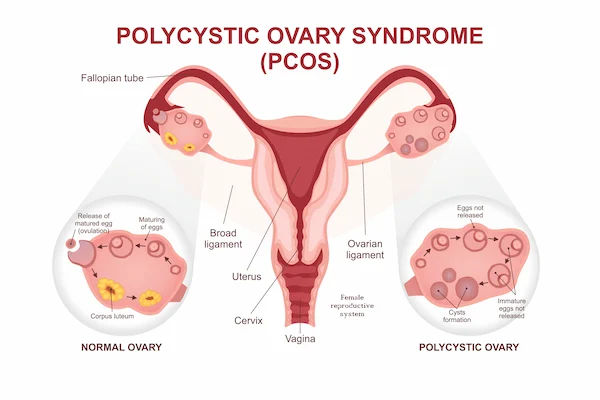How To Reduce Period Pain?
Relieve period pain with natural remedies like heat therapy, gentle exercise, and herbal teas. For stronger relief, try pain relievers, hydration, and relaxation techniques.

Written by
Last updated on 3rd Jul, 2025
The menstrual cycle is a natural process that prepares the body for pregnancy every month. It starts on the first day of menstruation and continues until the start of the next cycle. Menstrual period or menstruation is the process through which the lining of the uterus sheds through the vagina. Generally, women experience pain or discomfort during the menstrual period. This condition is known as dysmenorrhoea. It occurs due to the fluctuation of the prostaglandin level and abnormal contractions between this chemical and the uterus.
Understanding Dysmenorrhoea
There are two types of dysmenorrhoea: primary dysmenorrhoea and secondary dysmenorrhoea.
Primary dysmenorrhoea
It's the medical term for period pain that comes back every time a woman gets a period. It's natural and not associated with another medical condition. This pain starts one or two days before the bleeding starts. Individuals may feel this pain as mild to severe in the lower abdomen, back, or tight areas. Usually, this pain ends within 2-3 days.
Secondary dysmenorrhoea
If the period is more painful due to an infection or other medical condition of the reproductive organs, it's known as secondary dysmenorrhoea. It starts before the menstrual cycle and lasts longer than typical menstrual pains. The primary condition is endometriosis, which causes secondary dysmenorrhoea. During this condition, the tissue lining of the uterus exceeds the outside of the uterus. It causes pelvic pain and a heavy period.
Some common indicators of dysmenorrhoea are:
Pain in the lower abdomen
Cramping in the lower abdomen
Pain spread down to the legs
Lower back pain
Weakness
Fatigue
Headaches
Home Remedies for Alleviating Period Pain
Research shows that heat therapies provide better results on period pain than taking medications. So, individuals can try heating pads or wrap a warm towel on their abdomen. It will help the uterus muscles relax, which causes period pain. It also enhances blood circulation to the abdomen, which helps alleviate the pain. One can buy the heating pads online or at a drugstore. Also, people should avoid using hot water bottles and electric heating pads as they are inconvenient.
Also, soaking in a hot bath will provide relaxation against abdominal, back muscles, and pelvic pain during this period. Again, one can boost the pain-relieving power by adding a few drops of essential oils such as lavender, rose or sage. But ensure that these oils are mixed with a carrier oil.
Additionally, individuals can use herbal teas to reduce period pain. Some research says that herbal teas can lessen menstrual pain and discomfort. Here are some popular herbal tea options chosen by people:
Ginger tea: It's made from pungent, spicy ginger root. Its pain-relieving and anti-inflammatory properties can help reduce pain and bloating.
Chamomile tea: This herbal tea is made from chamomile flowers and incorporates a gentle floral taste. Though it doesn't directly impact menstrual pain, it can promote good-quality sleep and reduce fatigue. These support the easing of menstrual pain.
Cinnamon tea: Made with dried cinnamon, it has a mild, spicy, sweet taste and a warm flavour. It may help in reducing inflammation and bloating related to the menstrual cycle.
Green tea: Made from dried Camellia Sinensis leaves, it has a mild floral and earthy taste. Containing the L-theanine compound helps to feel more relaxed and calm. Also, it's a rich source of anti-inflammatory and antioxidant compounds.
Physical Activities and Exercises
Researchers found that 45-60 minutes of exercise 3 times per week can reduce period pain. Also, exercise and physical activity can improve mood, help in weight management, and reduce fatigue. Even 15 minutes of walking a day can provide benefits. But people must avoid strenuous activities. Instead, they can perform moderate to low-intensity activities such as yoga, meditation, breathing exercises, etc. A study observed that a specific yoga-based program has improved period pain and quality of life.
Here are some specific exercises to relieve menstrual cramps:
Paschimottanasana/Western stretch
Sit on the floor and stretch the legs. Place a bolster perpendicularly across the thighs. Then pile another block over the bolster. Try to drape over the supports/props with the forehead. If the supports are low, then heighten them with more blankets. Let the arms be relaxed.
Fish pose
Place a pillow on the floor. Then, lie on the pillow by placing the back and head on it. Ensure the legs are straight in front of the floor. Gently place the arms to the side. Breathe gently.
Cow pose
Get on with the hands and knees. Hands should be directly under the shoulders, and knees should be under the hips. Take a deep breath and try to lower the belly towards the ground. Gently stretch the neck and head.
Medical Treatments and Options
Over-the-counter (OTC) pain relievers help to bring down period cramps and other associated pains effectively. The American College of Obstetricians and Gynaecologists recommend non-steroidal anti-inflammatory drugs (NSAIDs) as the best medications for period pain. Common NAIDs are ibuprofen, aspirin, and naproxen. They cut the number of prostaglandins that can lessen the effects of period pain.
If the pain doesn't improve by taking these OTC medications, the doctor might prescribe alternative pain relievers or use an intrauterine device (IUD). For instance, hormonal IUDs make the period lighter and less painful.
Lifestyle Changes for Long-Term Relief
A healthy diet is beneficial to reduce period pain. So, people should eat fresh fruits, vegetables, fish, seafood, leafy greens, lentils, and nuts. Also, they must avoid processed foods and foods with high sugar. Apart from these, they must drink enough water to stay hydrated.
Stress acts as the catalyser for period pain. Thus, stress management is necessary at this time. Taking sufficient sleep (8 hours) and rest can heal the body. Also, practising mindfulness and hobbies will be helpful.
When to Consult a Healthcare Professional
Though period pains are common, some signs should not be ignored. In these cases, people must consult a healthcare professional.
The pain is so severe that it disrupts daily activities.
Severe cramps start suddenly after age 25.
These signs may indicate some underlying conditions such as endometriosis, pelvic inflammatory disease (PID), uterine fibroids, etc. So, the doctor will recommend these tests to diagnose the symptoms.
Ultrasound: This test involves the usage of high-frequency sound waves that create images of the uterus and other internal organs.
Magnetic resonance imaging (MRI): With this procedure, the lab technicians generate detailed images of different organs and body structures using radio frequencies, large magnets, and a computer.
Hysteroscopy: Hysteroscopy is a procedure where doctors use a special viewing instrument called a hysteroscope, which is inserted through the vagina. This allows them to get a clear view of the cervix and the inside of the uterus.
Laparoscopy: During this procedure, the doctor can find abnormal growths in the pelvic and abdominal area. They use a laparoscope, a thin tube with a lens and light, which is inserted through a small incision in the abdomen.
Alternative Therapies for Period Pain
Alternatively, people can take therapies such as acupuncture and acupressure to reduce the pain. Acupuncture can reduce the severity and intensity of primary dysmenorrhoea. With this procedure, the practitioner inserts needles at specific points of the body to stimulate them. This improves the feasibility of muscle, blood flow, and pain processing in the central nervous system.
Acupressure is a non-invasive process that requires putting pressure on specific body parts to ease the pain. Several researches have shown that acupressure can reduce the duration and severity of period pain. Older research proved that rubbing the circles on the calf above a point of the ankle can reduce period pain.
Myths and Facts about Period Pain Management
Here are some common myths about period pain management. But know the facts behind these:
Physical activity can disturb the menstrual period.
Light exercises and physical activities can help relieve period pain.
Foods such as tamarind, pickles, and curd can disturb the menstrual flow.
Foods can't impact the period flow.
Painkillers should be avoided
Over-the-counter pain relievers like ibuprofen are safe and effective.
Conclusion
Usually, period pain comes at the beginning of menstruation and goes as it ends. Some women experience severe, and for some, it will be mild. For mild pain, there are several home remedies and OTC medication. However, in the case of severity, people should get medical help. The doctor will give a personalised treatment after diagnosing the symptoms.
Consult Top General Physicians
Consult Top General Physicians

Dr. Swagata Sircar
General Physician/ Internal Medicine Specialist
8 Years • MBBS, MD General Medicine
Kolkata
HealthYou Speciality Clinic & Diagnostics., Kolkata

Dr. Dhanraj K
General Physician/ Internal Medicine Specialist
25 Years • MBBS, MD Internal Medicine - Osmania Medical College, Hyderabad
Hyderabad
Apollo Hospitals Jubilee Hills, Hyderabad
(375+ Patients)

Dr. Swarna Deepak K
General Physician/ Internal Medicine Specialist
17 Years • MBBS: MD (Internal Medicine) MRCP (UK), EDIC (European Diploma in Critical Care), IDCCM, IFCCM (Critical Care), FID (Royal Liverpool Academy)
Hyderabad
Apollo Hospitals Jubilee Hills, Hyderabad
(375+ Patients)

Dr. Harshendra Jaiswal
General Physician/ Internal Medicine Specialist
12 Years • MBBS , MD (General medicine)
Kolkata
108 DHANA DHANVANTARI Clinic, Kolkata
(25+ Patients)

Dr Syed Mateen Pasha
General Physician
2 Years • MBBS
Bengaluru
PRESTIGE SHANTHINIKETAN - SOCIETY CLINIC, Bengaluru

